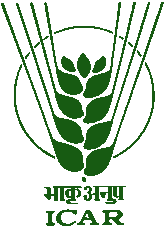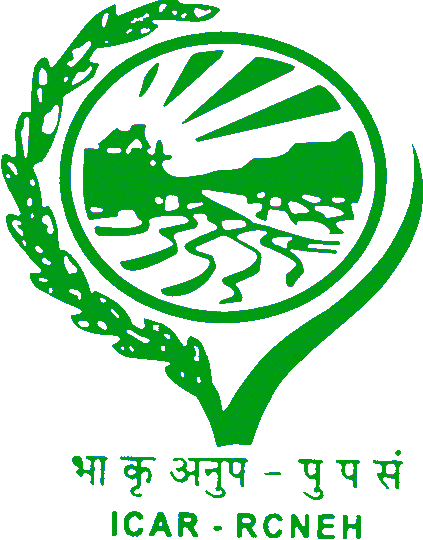
Natural Resource Management
Analysis of soil and plant samples from different districts of Nagaland
579 nos. of soil samples were analyzed in the laboratory covering 7 districts viz., Dimapur, Peren, Kohima, Wokha, Mon, Tuensang and Phek for N, P, K, Organic Carbon (OC), pH, and EC during 2012-13. The ranges of average N, P, K, OC and pH of all these soil samples were 68.99-338.69 kg/ha, 1.04-213.03 kg/ha, 21.50-507.02 kg/ha, 0.51-2.68%, 3.51-7.90, and 0.04-0.330, respectively. Besides, only 20 nos. of plant samples and 96 nos. of vermicompost samples were also analyzed during 2012-13.
Model farming system for resilient shifting cultivation in Nagaland
Two jhum fields were selected in Medziphema and Jharnapani and three systems were compared viz. agri-silvi-livestock, agri-horti-silvi and traditional jhum. Contour bunds by using wooden log (locally khown as ‘Echo’) were constructed to prevent soil loss. Pits were made to plant fruit crops and some pits were left to use these as a water recharge trench. All infrastructural facilities like pig shed, plot layout, contour bunding, water harvest structure, piglets, manures etc. were provided to the beneficiaries. Besides, scientists and technical officers visited to the field regularly and gave technical guidance. Through this approach, these beneficiaries harvested good yield of all crops except Bhalum-4 variety of rice. For instance, in an area of 0.21 ha in each system in Medziphema, the harvest is listed in the folloeing table.
Harvest (kg) in traditional jhum, agri-silvi-livestock and agri-horti-silvi systems in a farmer’s field in Medziphema
579 nos. of soil samples were analyzed in the laboratory covering 7 districts viz., Dimapur, Peren, Kohima, Wokha, Mon, Tuensang and Phek for N, P, K, Organic Carbon (OC), pH, and EC during 2012-13. The ranges of average N, P, K, OC and pH of all these soil samples were 68.99-338.69 kg/ha, 1.04-213.03 kg/ha, 21.50-507.02 kg/ha, 0.51-2.68%, 3.51-7.90, and 0.04-0.330, respectively. Besides, only 20 nos. of plant samples and 96 nos. of vermicompost samples were also analyzed during 2012-13.
Model farming system for resilient shifting cultivation in Nagaland
Two jhum fields were selected in Medziphema and Jharnapani and three systems were compared viz. agri-silvi-livestock, agri-horti-silvi and traditional jhum. Contour bunds by using wooden log (locally khown as ‘Echo’) were constructed to prevent soil loss. Pits were made to plant fruit crops and some pits were left to use these as a water recharge trench. All infrastructural facilities like pig shed, plot layout, contour bunding, water harvest structure, piglets, manures etc. were provided to the beneficiaries. Besides, scientists and technical officers visited to the field regularly and gave technical guidance. Through this approach, these beneficiaries harvested good yield of all crops except Bhalum-4 variety of rice. For instance, in an area of 0.21 ha in each system in Medziphema, the harvest is listed in the folloeing table.
Harvest (kg) in traditional jhum, agri-silvi-livestock and agri-horti-silvi systems in a farmer’s field in Medziphema
Crop
|
Harvest (kg)
|
Crop
|
Harvest (kg)
|
Traditional jhum
|
(0.21 ha cropped area)
|
Agri-horti-silvi
|
(0.21 ha cropped area)
|
Rice (Lokhomo)
|
675.0
|
Beans
|
4.0
|
Sticky Rice
|
100.0
|
Chilli
|
3.5
|
Maize
|
53.0
|
Bitter Gourd
|
12.5
|
Colocasia
|
12.0
|
Pumpkin
|
104.0
|
Local Pumpkin
|
51.0
|
Local long bean
|
147.0
|
Agri-silvi-livestock
|
(0.21 ha cropped area)
|
Colocasia
|
15.0
|
Colocasia
|
31.0
|
Maize
|
65.0
|
Maize
|
76.0
|
Cucumber
|
3.0
|
Rice (Bhalum-4)
|
Not Harvested
|
Rice (Bhalum-4)
|
Not Harvested
|
In traditional jhum, the traditional paddy varieties like Lokhomo and local gum rice; maize, colocasia and local pumpkin were planted. Improved paddy variety Bhalum-4, maize and colocasia were planted in agri-silvi-livestock model. Pig-shed was constructed along with collecting pit for recharging soil with decomposed pig manure. Fruits plants like Khasi mandarin, round lemon, mango, mosambi, litchi, colocasia and vegetables like beans, chilli, brinjal, yard long bean, bitter gourd, pumpkin, colocasia and cucumber were integrated with maize and paddy var. Bhalum-4 in agri-horti-silvi model. A total of 811 kg, 107 kg and 354 kg of produce were harvested from traditional jhum, agri-silvi-livestock and agri-horti-silvi model, respectively. However, the paddy variety var. Bhalum-4 in agri-silvi-livestock and agri-horti-silvi model was completely failed due to sudden outbreak of Gundhi bug. On the contrary, Lokhomo and local gum rice were unaffected. Another reason could be the time of sowing. All rice cultivars were sown delayed by one month, which might have affected the improved variety, but locals were escaped due to its long acclimatization with the place.
Besides this, alder based jhum system were developed at Longleng and Wokha. Model systems were developed at ICAR farm at Jharnapani and Wokha and in farmer’s field at Medziphema. All together 53 piglets were distributed for inclusion of animals in jhum at Dimapur, Phek, Wokha, Longleng and Kohima districts of Nagaland. Pigshed were also constructed at Jharnapani, Medziphema, K-Basa villages. Three days training were organized at Mission centre, Vankhosung, Wokha district for 45 nos. of participants.
Besides this, alder based jhum system were developed at Longleng and Wokha. Model systems were developed at ICAR farm at Jharnapani and Wokha and in farmer’s field at Medziphema. All together 53 piglets were distributed for inclusion of animals in jhum at Dimapur, Phek, Wokha, Longleng and Kohima districts of Nagaland. Pigshed were also constructed at Jharnapani, Medziphema, K-Basa villages. Three days training were organized at Mission centre, Vankhosung, Wokha district for 45 nos. of participants.
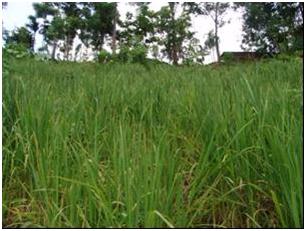
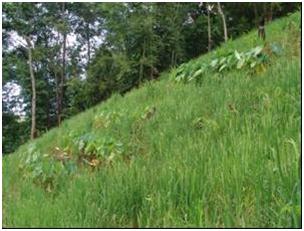
Jhum field at Medziphema site
Livelihood improvement and empowerment of rural poor through sustainable farming systems in north-east India
Improved and high yielding planting materials of 2 kg of rice (Bhalum-4), 5 kg pencil/faba bean (Annapurna), 1.4 kg of radish (B-4432), 120 g of cabbage (Samrat), 60 g of tomato (Bioseed 56), 100 g of onion (Nasik red), 300g of coriander (Ramses), 6 quintal of potato (K. Jyoti and Megha Jyoti), 2 kg of bhindi (Tokita), 1 kg of bean (Yard Long), 800 g of bitter gourd (Champian), 1 kg of ridge gourd (F1 hybrid) and 600 g of cucumber (Garima Super) were distributed. Besides, they also planted maize, colocasia, tapioca and yam from the seeds saved in last year. To create awareness about the fertilizer application as well as to fertilizer HYVs supplied to them, 150 kg of DAP, 200 kg of MOP and 200 kg of Urea were distributed. Guidance was offered to them for application of fertilizer at right dose and at right time. Large cardamom planted with agro-forestry started yielding. Plantation of 0.16 ha large cardamom yielded 60 kg of fresh capsules and after sun-drying yield came to 15.2 kg of dry capsules. Each kg of dry capsules fetched Rs. 500 in the market and thus gross income of Rs. 7600 has been generated.
Improved and high yielding planting materials of 2 kg of rice (Bhalum-4), 5 kg pencil/faba bean (Annapurna), 1.4 kg of radish (B-4432), 120 g of cabbage (Samrat), 60 g of tomato (Bioseed 56), 100 g of onion (Nasik red), 300g of coriander (Ramses), 6 quintal of potato (K. Jyoti and Megha Jyoti), 2 kg of bhindi (Tokita), 1 kg of bean (Yard Long), 800 g of bitter gourd (Champian), 1 kg of ridge gourd (F1 hybrid) and 600 g of cucumber (Garima Super) were distributed. Besides, they also planted maize, colocasia, tapioca and yam from the seeds saved in last year. To create awareness about the fertilizer application as well as to fertilizer HYVs supplied to them, 150 kg of DAP, 200 kg of MOP and 200 kg of Urea were distributed. Guidance was offered to them for application of fertilizer at right dose and at right time. Large cardamom planted with agro-forestry started yielding. Plantation of 0.16 ha large cardamom yielded 60 kg of fresh capsules and after sun-drying yield came to 15.2 kg of dry capsules. Each kg of dry capsules fetched Rs. 500 in the market and thus gross income of Rs. 7600 has been generated.
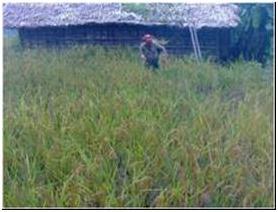
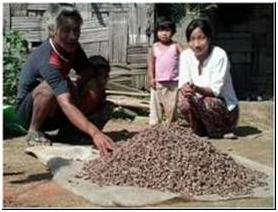
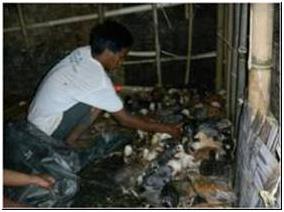
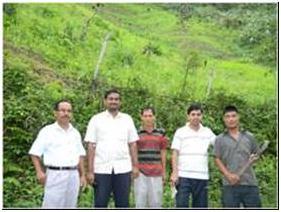
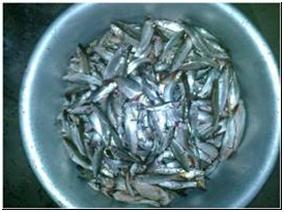
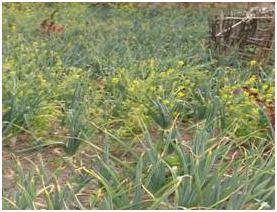
Different activities at Mon district under NAIP project
In addition to this, a total of 5000 nos. of Titachap (Michelia champaca) and Hollock (Terminalia myriocarpa) seedlings were planted in a cropped area of 12.5 ha among 6 numbers of beneficiaries. Nine numbers of low cost poultry shed were established and distributed 1700 nos. of Vanaraja birds to 9 progressive farmers. About 1500 of fish fingerling were reared in pig-fish integration among 2 farmers. Two nos. of honey extractor have been distributed to 6 nos. of beneficiaries who were already given honey box. Two more villages Phuktong and Tuimei were now under the activity of NAIP in Mon district. In Tuimei village, 20 nos. of terraces were constructed with a net area of 321.34 sqm along with a water harvesting structure to ensure irrigation during winter period for growing high value vegetables. Twenty pairs of rabbit along with cage were distributed among 20 beneficiaries in Tuimei.
Effect of elevated temperature on soil carbon sequestration, microbial biomass and enzymatic activities under different land use of Nagaland
Soils from variable land use under 3 soil orders (Entisols, Inceptisols and Alfisols) were collected and samples were incubated in BOD incubator at different temperatures for 1 month and analyzed for pH, EC, available nitrogen, available phosphorus, available potassium, microbial biomass carbon etc.
Effect of elevated temperature on soil carbon sequestration, microbial biomass and enzymatic activities under different land use of Nagaland
Soils from variable land use under 3 soil orders (Entisols, Inceptisols and Alfisols) were collected and samples were incubated in BOD incubator at different temperatures for 1 month and analyzed for pH, EC, available nitrogen, available phosphorus, available potassium, microbial biomass carbon etc.
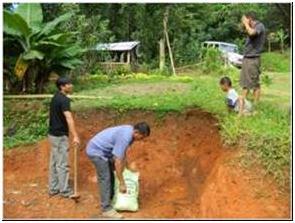
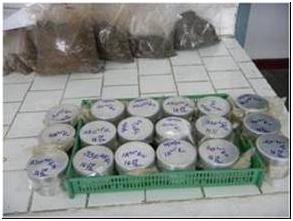
Soil collection and experimental set up to study the effect of elevated temperature
Resilient shifting cultivation for sustainable soil-water-nutrient-plant continuum in hilly agriculture system of Nagaland
The experimental design are composed of 5 treatments such as T1 (Control-forest), T2 (Traditional jhum), T3 (Traditional jhum with minor interventions), T4 (Improved jhum 1), and T5 (Improved jhum 2). Field was selected and soil samples for ‘before cutting’ and ‘after burning’ have been collected for analysis in all the treatments. Traditional jhum system, which is simply a mixed cropping in a slashed and burnt land with traditional varieties of upland rice, maize and colocasia etc. were already established. Traditional jhum with minor interventions like improved variety of seeds like SARS-1 and SARS-2; line sowing etc. were also established. Pig shed construction was completed for ‘animal intervention’ in jhum. Contour bunds had been developed at 10-15 meter interval, on which alternatively colocasia and hedge plant were grown.
Validation of indigenous techniques knowledge for weed management in sustainable production of jhum rice
The field experiment was initiated in the farmers' jhum field of Medziphema village with ten different doses of common salt (20, 40, 60, 80, 100, 120, 140, 160, 180, and 200 kg/ha) at 20 and 40 DAS, weedy check and control (weedy) in randomized complete block design with three replications. Due to scanty of weeds at 20 and 40 DAS, application schedule of common salt was shifted at 45 and 75 DAS, when some weed growth was observed. Even at 45 DAS weed growth was found to be negligible. This might be due to proper burning which resulted in complete destruction of weed seeds. At 75 DAS, no ‘grassy’ weeds were observed, only broad leave weeds were observed. Plots applied with 18 per cent common salt produce maximum grain yield, followed by 12 and 20 per cent. Straw yield was highest in 8, 18, 20 per cent salt applied plots. Eighteen per cent common salt application leads to maximum harvest index. However, electrical conductivity has increased by 0.07 - 0.056 dS m-1 with an average of 0.056 dS m-1 after salt application twice during the jhum period.
The experimental design are composed of 5 treatments such as T1 (Control-forest), T2 (Traditional jhum), T3 (Traditional jhum with minor interventions), T4 (Improved jhum 1), and T5 (Improved jhum 2). Field was selected and soil samples for ‘before cutting’ and ‘after burning’ have been collected for analysis in all the treatments. Traditional jhum system, which is simply a mixed cropping in a slashed and burnt land with traditional varieties of upland rice, maize and colocasia etc. were already established. Traditional jhum with minor interventions like improved variety of seeds like SARS-1 and SARS-2; line sowing etc. were also established. Pig shed construction was completed for ‘animal intervention’ in jhum. Contour bunds had been developed at 10-15 meter interval, on which alternatively colocasia and hedge plant were grown.
Validation of indigenous techniques knowledge for weed management in sustainable production of jhum rice
The field experiment was initiated in the farmers' jhum field of Medziphema village with ten different doses of common salt (20, 40, 60, 80, 100, 120, 140, 160, 180, and 200 kg/ha) at 20 and 40 DAS, weedy check and control (weedy) in randomized complete block design with three replications. Due to scanty of weeds at 20 and 40 DAS, application schedule of common salt was shifted at 45 and 75 DAS, when some weed growth was observed. Even at 45 DAS weed growth was found to be negligible. This might be due to proper burning which resulted in complete destruction of weed seeds. At 75 DAS, no ‘grassy’ weeds were observed, only broad leave weeds were observed. Plots applied with 18 per cent common salt produce maximum grain yield, followed by 12 and 20 per cent. Straw yield was highest in 8, 18, 20 per cent salt applied plots. Eighteen per cent common salt application leads to maximum harvest index. However, electrical conductivity has increased by 0.07 - 0.056 dS m-1 with an average of 0.056 dS m-1 after salt application twice during the jhum period.
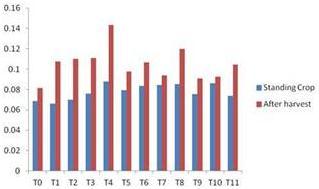
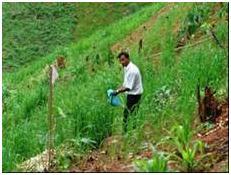
Development of Non-forest Wastelands through Agro-forestry Models in Nagaland State of NEH Region
A total area of 18.25 ha of degraded land has been rehabilitated. The project sites, confined in six districts of the state viz., Dimapur, Mokokchung, Kohima and Peren were first surveyed and appropriate agroforestry models have been established. The main emphasis is given to horticulture in these areas. The establishment of models at Longleng (1 ha) and Wokha (2 ha) are in progress. Three nurseries to raise tree saplings have been established at Jharnapani, Khaibung and Athibung areas. One training on livelihood security through horticulture based farming system and backyard poultry at Songlhuh, Peren district where 60 farmers have been participated.
A total area of 18.25 ha of degraded land has been rehabilitated. The project sites, confined in six districts of the state viz., Dimapur, Mokokchung, Kohima and Peren were first surveyed and appropriate agroforestry models have been established. The main emphasis is given to horticulture in these areas. The establishment of models at Longleng (1 ha) and Wokha (2 ha) are in progress. Three nurseries to raise tree saplings have been established at Jharnapani, Khaibung and Athibung areas. One training on livelihood security through horticulture based farming system and backyard poultry at Songlhuh, Peren district where 60 farmers have been participated.
Changes in EC over salt application
Salt application in jhum field

